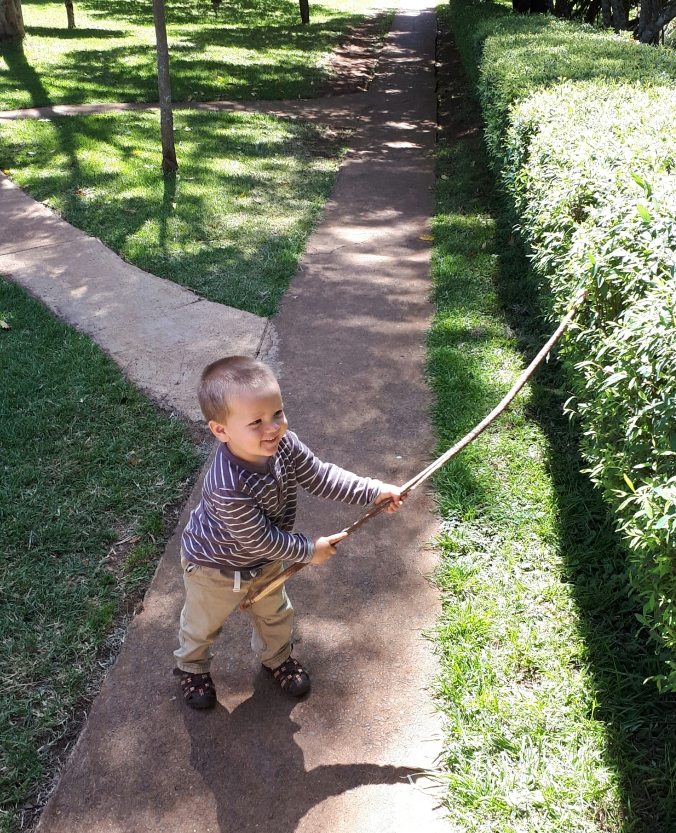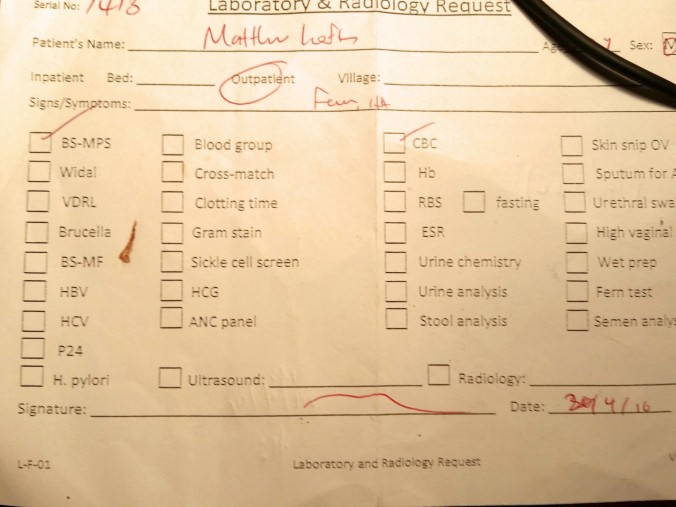The smallest things can be a big deal. Just ask my son, who this weekend had a piece of raw carrot no larger than his thumbnail go into his trachea instead of his esophagus. Maggie and I had just gotten back from an afternoon down at Tenwek Hospital, about an hour from our hospital in Litein, where we were visiting this weekend. Tenwek was instrumental in starting one of the first surgical residencies in Africa and has already trained many African surgeons, including our friend and future next-door neighbor in Litein, Dr. Blasto.
As we walked into the house, my son Leo (almost 3 years old) was enjoying a carrot. Now, we eat a lot of carrots in our household – about 2 kg a week. They’re not messy, they’re healthy, and they won’t spoil your dinner, so that 2kg actually ends up running out after about 4 or 5 days on an average week. My eyes turned yellow when I was younger from all the carrots I ate, and I’m kind of surprised the same thing hasn’t happened to my kids yet.
But on this particular night, somehow (perhaps he was just too excited to see us?) a piece of carrot went down the wrong hole. Leo began coughing and would not stop, no matter how hard I thwacked his back or attempted to give him a Heimlich. He managed to breathe and speak in between coughs, so I knew that he was okay but it was still a little disturbing to hear my child constantly coughing.
Eventually the coughing settled down and the audible wheezing and stridor began. Leo was happy, content, and no longer coughing but as he sat reading a book to himself I could hear him breathe from across the room, whistling and honking with each relatively comfortable breath.
Uh-oh.
When airflow through one’s lungs is turbulent but not entirely blocked, it produces a variety of weird sounds (mostly high-pitched), which meant that even though the coughing spasms were no longer an issue, there was clearly still something in his windpipe causing some turbulence. Given the physical properties of both the carrot and tracheal tissue, this was an issue that was not going to resolve on its own and would probably just get worse as bacteria built up around the little hunk of carrot.
I called Dr. Blasto for his opinion, which was that we drive back to Tenwek Hospital. Since a foreign body like a piece of carrot that is only partially obstructing the flow of air can rather rapidly move to a position where it completely obstructs the flow of air, he felt it best to get Leo to a hospital where the carrot could be removed as quickly as possible. So an ambulance was called.
Leo was excited to ride the ambulance, though he was a bit unimpressed by the fact that the ambulance did not light up or make the same “WEE-OOH WEE-OOH” sound that he made in between wheezes as soon as we told him that he’d be riding an ambulance. Dr. Blasto graciously agreed to come along for the bumpy ride; it took us about half an hour (in the dark, no less) to make a journey that we had made earlier that day in twice that time.
Once we got to Tenwek, Leo was evaluated by the medical team there and they decided that since it was late on a Friday night and he was perfectly stable, they would do a bronchoscopy (sticking a tube down his throat to look for the errant piece of carrot) in the morning when they had more staff immediately available. Both he and I were quite tired (and his audible wheezing had stopped after the bumpy car ride), so were glad for some time to rest and relieved that it wasn’t bad enough to require immediate surgery.
We stayed at a lovely guest room for the night. Sleep was difficult for Leo – not sure if the carrot in his trachea was bothering him on and off or it was just an unfamiliar environment, but we eventually managed to get to sleep and then get up in time to get over the hospital. We had to wait a few extra hours because of an emergency our surgeon had to attend to, but eventually Leo got in, got the piece of carrot out of his trachea, and got to the recovery room. We spent the rest of the afternoon chatting with another family teaching in the Family Medicine residency before heading home.

Leo in the recovery room.
One of the worst parts about being a doctor is being aware of all the terrible ways that my child could suffer a medical emergency without any warning: a piece of food in the wrong place, a head colliding on the cement floor, or an infection out of control. So I know it could have been a lot worse and I’m thankful that it wasn’t, but the whole episode was disquieting. We were miles away from the nearest bronchoscope, just as we were miles away from many other medical interventions that we might possibly need at a moment’s notice.
The human body is as resilient as it is fragile. It is a wonder that our bodies can heal and protect themselves, but the cruel realities of the world are such that many people – especially children – are vulnerable to disease and trauma. We can recover from many injuries and illnesses, but others not so much.
In the West, we usually take access to certain medical interventions when emergencies strike, but these interventions are still beyond the reach of many children. Even those who live near a hospital may still be in danger – last week I saw a child who had been brought to a government hospital in the middle of the night with extremely high fever and rapid breathing that was not even seen by a medical provider. She was later taken to a mission hospital and admitted to the pediatric ICU immediately.
The harsh sounds of my son’s breathing reminded us quite viscerally of the risks of living in a place without quick access to medical care. Yet it also reminded us of why we came to live here in the first place: many of the children around us don’t have a surgeon on speed dial and don’t have someone who will just arrange for an ambulance to speed through the night. If it wasn’t for the work of the PAACS residency doing what our family does except for training surgeons, we might not have had a capable African surgeon ready to evaluate and treat our child right away. Our work is only a tiny, tangential part of equipping and strengthening the health system here, but we believe that the little bit we can do might better equip health practitioners and the hospitals they work in to better serve their communities.
Our son recovered from his procedure very well and was peeling himself a carrot to eat on Tuesday morning. (Why we left the carrot peeler out where a child could cut himself with it and necessitate another emergency intervention is beyond me.) Our scary little interlude was mercifully short and not nearly as scary as it could have been, but it reinforced for us how tenuous our life is – and how important it is that we are here.









